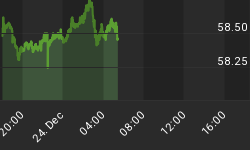
When the Tokyo Nikkei 225 Index dropped more than 400 points on Tuesday and Wednesday last week, the Japanese yen appeared ready to challenge the critical resistance of 86 (0.0086 per US Dollar). I alerted my readers, in my Wednesday's Follow-Up to last Sunday's Carry Trade Challenges, of a possible global selloff when the yen breaks through 86. The confluence of the Japanese yen pushing towards this critical resistance and the Dollar to yen exchange rate testing the vulnerable 38.2% Fibonacci Retracement support of 116.34 indicated a probable massive unwinding of the yen carry trade last week.
The Japanese yen had since jumped 2.2% to 0.00879 per US Dollar, and the Dollar had declined to below 114 per yen. And, the markets around the world sold off on Friday. The Dow Jones World Index dropped 1.65% on Friday with, most notably, 2 of the Dow Jones China indexes plunged more than 3% each. The selloff back in the U.S. slashed 366.94 points, or 2.64%, off the Dow Jones Industrial Average, which had turned back the clock and brought us right back to 9/18/2007, the day the Fed cut 0.50% off the Fed Fund's rate.
So, here we are. After all the re-inflation efforts by the Fed, we're now 217 points below the 9/18/2007 DJIA closing price. And, we're stuck with the Dollar at all time low and the oil price at all time high. It seems that the Fed's so called brilliant "surgical strike" had wreaked havoc for the Main Street and done nothing to save Wall Street from the inevitable. Consumers are now paying 44% more for eggs and 21% more for milk over the past 12 months. The USDA's thrifty food plan costs for a family of 4 (with children 3-5 years old) showed an increase of 5.54% in August, from the same month a year ago. And, that increase was just for food. August was also the month before the Dollar began to fall off the cliff. The bottom 50% in the U.S. are already fighting over the remaining 12% income. The last things they need are higher food and energy prices.
O.K. moving forward... The SPX (S&P 500 Index) lost 2.56% on Friday. 1.50% of the loss came in the afternoon session. As bad as that was, the money flow in the afternoon session had actually improved, except for the Consumer Goods and the Tech sectors (see Chart 1). This divergence indicates investors, who believed in buying on the dips, might've come back to do so in the afternoon.

Chart 1
In addition, the NYSE and the Nasdaq Trin Indexes skyrocketed into the extreme oversold stratosphere of 3.54 and 2.26 respectively on Friday. And, when the pendulum's over swung like that, it's likely for the market to try to locate the equilibrium point. Incidentally, I thought Friday's selloff was anything but panic selling. It was eerily methodical and relatively calm. It shouldn't be much of a surprise to see a short-term rebound after another round of selloff in Asia tonight (Monday in Asia). It's likely for the U.S. market to sink lower following the Asian markets. But, the market should bounce back after that. The long-term picture, nevertheless, continues to remain quite gloomy.
When I wrote about the forming of a market top in the final week of September, one of my concerns, besides the yen carry trade, was based on the divergence between the S&P 500 Index (SPX) and the S&P Retail Index (GSPMS). I mentioned that the boom in the retail sector (gray curve) was what took the SPX to its new high in July (blue circle on Chart 2 below). And, while the SPX had reached the new high in July, the GSPMS had already started to diverge from the SPX by then. The gap between the SPX and the GSPMS subsequently grew so wide (red arrows) that a technical recalibration had to take place in order to set the engine running smoothly again. But, after last week's correction, the gap grew even wider (red circles). This indicates that further adjustments will be needed.

Chart 2
But, the GSPMS' divergence with the SPX is nothing compares to its divergence with the Nasdaq Composite Index (see red circles on Chart 3 below). Essentially, for about a month, the tech-heavy Nasdaq Index was on its own zero gravity parabolic flight while the retail sector, which incidentally sells these tech companies' products, was in a deep hole back on earth.

Chart 3
If the SPX needed to be recalibrated, the Nasdaq would probably need a major tuneup. In order for the market to get back on track, the variance between the producers and the retailers of their products will have to be corrected.















